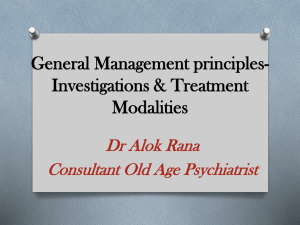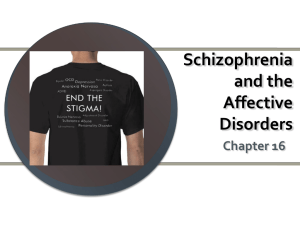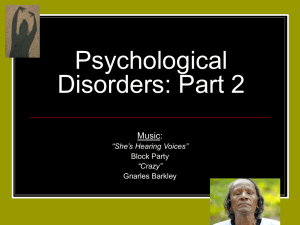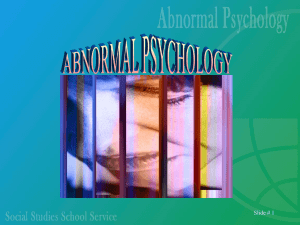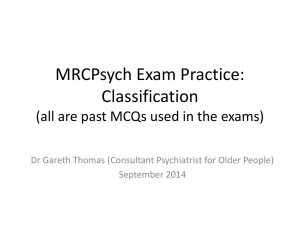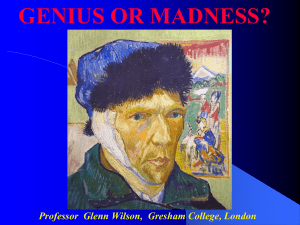Chap16
advertisement
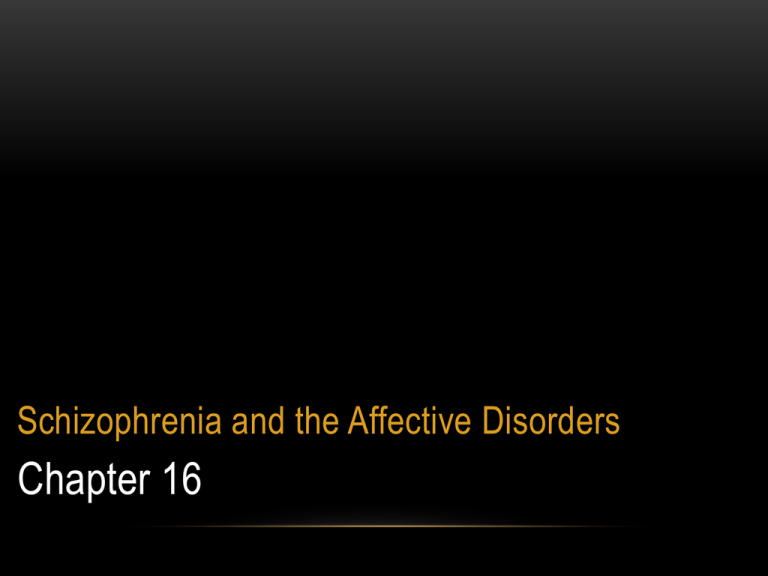
Schizophrenia and the Affective Disorders Chapter 16 Schizophrenia Description • Schizophrenia is a serious mental disorder that afflicts approximately 1 percent of the world’s population. • Its monetary cost to society is enormous; in the United States, this figure exceeds that of the cost of all cancers (Thaker and Carpenter, 2001). • Descriptions of symptoms in ancient writings indicate that the disorder has been around for thousands of years (Jeste et al., 1985). 2 3 Schizophrenia Heritability • If schizophrenia were a simple trait produced by a single gene, we would expect to see this disorder in at least 75 percent of the children of 2 schizophrenic parents if the gene were dominant. • If it were recessive, all children of two schizophrenic parents should become schizophrenic. • However, the actual incidence is less than 50 percent, which means either that several genes are involved or that having a “schizophrenia gene” imparts a susceptibility to develop schizophrenia, the disease itself being triggered by other factors. 4 Schizophrenia Heritability • Gottesman and Bertelsen (1989) found that the percentage of schizophrenic children was identical for both members of such pairs: 16.8 percent for the schizophrenic parents and 17.4 percent for the nonschizophrenic parents. • For the dizygotic twins, the percentages were 17.4 percent and 2.1 percent, respectively. • These results provide strong evidence for the heritability of schizophrenia and also support the conclusion that carrying a “schizophrenia gene” does not mean that a person will necessarily become schizophrenic. (See Figure 16.1.) 5 Schizophrenia Pharmacology of Schizophrenia: The Dopamine Hypothesis • Pharmacological evidence suggests that the positive symptoms of schizophrenia are caused by abnormalities in DA neurons. • The dopamine hypothesis suggests that the positive symptoms of schizophrenia are caused by overactivity of DA synapses. • Chlorpromazine was tried on patients with a variety of mental disorders: mania, depression, anxiety, neuroses, and schizophrenia (Delay and Deniker, 1952a, 1952b). • Chlorpromazine • a dopamine receptor blocker; a “first generation” antipsychotic drug • The drug was not very effective in treating neuroses or affective psychoses, but it had dramatic effects on schizophrenia. 6 Schizophrenia Effects of Dopamine Agonists and Antagonists • The discovery of the antipsychotic effects of chlorpromazine profoundly altered the way in which physicians treated schizophrenic patients and made prolonged hospital stays unnecessary for many of them (the patients, that is). • The efficacy of antipsychotic drugs has been established in many double-blind studies (Baldessarini, 1977). • The drugs actually eliminate, or at least diminish, the patients' positive symptoms. • These drugs were found to have one property in common: They block D 2 and D3 dopamine receptors (Creese, Burt, and Snyder, 1976; Strange, 2008). • 7 Schizophrenia Effects of Dopamine Agonists and Antagonists • Another category of drugs has the opposite effect: namely, production of the positive symptoms of schizophrenia. • The drugs that can produce these symptoms have one known pharmacological effect in common: They act as dopamine agonists. • These drugs include amphetamine, cocaine, and methylphenidate (which block the reuptake of dopamine) and L-DOPA (which stimulates the synthesis of dopamine). • The symptoms that these drugs produce can be alleviated with antipsychotic drugs, a result that further strengthens the argument that the antipsychotic drugs exert their therapeutic effects by blocking dopamine receptors. 8 9 Schizophrenia Consequences of Long-Term Drug Treatment of Schizophrenia • Individuals with schizophrenia may develop symptoms of a neurological disorder called tardive dyskinesia. • Tardus means “slow,” and dyskinesia means “faulty movement”; thus, tardive dyskinesia is a latedeveloping movement disorder. • Tardive Dyskinesia • a movement disorder that can occur after prolonged treatment with antipsychotic medication; characterized by involuntary movements of the face and neck • Tardive dyskinesia appears to be the opposite of Parkinson's disease. • Whereas patients with Parkinson's disease have difficulty moving, patients with tardive dyskinesia are unable to stop moving. • Indeed, dyskinesia commonly occurs when patients with Parkinson's disease receive too much L-DOPA. 10 Schizophrenia Consequences of Long-Term Drug Treatment of Schizophrenia • The accepted explanation for tardive dyskinesia has been a phenomenon known as supersensitivity—a compensatory mechanism in which some types of receptors become more sensitive if they are inhibited for a period of time by a drug that blocks them. • Presumably, when D 2 receptors in the caudate nucleus and putamen are chronically blocked by an antipsychotic drug, they become supersensitive, which in some cases overcompensates for the effects of the drug, causing the neurological symptoms to occur. 11 Schizophrenia Evidence for Brain Abnormalities in Schizophrenia • The relative ventricle size of the schizophrenic patients was more than twice as great as that of normal control subjects. (See Figure 16.3.) • The most likely cause of the enlarged ventricles is loss of brain tissue; thus, the scans provide evidence that chronic schizophrenia is associated with brain abnormalities. 12 Schizophrenia Evidence for Brain Abnormalities in Schizophrenia • In fact, Hulshoff-Pol et al. (2002) found that although everyone loses some cerebral gray matter as they age, the rate of tissue loss is greater in schizophrenic patients. 13 Schizophrenia Epidemiological Studies • Many studies have shown that people born during the late winter and early spring are more likely to develop schizophrenia—a phenomenon known as the seasonality effect. • Seasonality Effect • the increased incidence of schizophrenia in people born during late winter and early spring • For example, Kendell and Adams (1991) studied the month of birth of over 13,000 schizophrenic patients born in Scotland between 1914 and 1960. • They found that disproportionately more patients were born in February, March, April, and May. (See Figure 16.5.) 14 15 Schizophrenia Epidemiological Studies • Because vitamin D plays an important role in brain development, this deficiency may be a risk factor for schizophrenia. • These considerations suggest that at least some of the increased incidence of schizophrenia in city dwellers and those who live in cold climates may be attributable to a vitamin D deficiency. 16 Schizophrenia Epidemiological Studies • As we saw in Chapter 14, sudden refeeding after a thiamine deficiency can cause brain damage. Other studies have shown that underweight women are more likely to give birth to babies who later develop schizophrenia and that low birth-weight babies have a higher incidence of schizophrenia (Kunugi, Nanko, and Murray, 2001; Wahlbeck et al., 2001). 17 Schizophrenia Complications of Pregnancy and Childbirth • A meta-analysis of eight studies by Cannon, Jones, and Murray (2002) found that the most important factors are complications of pregnancy, including diabetes of the mother, Rh incompatibility between mother and fetus, bleeding, and preeclampsia (also known as toxemia, a condition characterized by high blood pressure, edema, and protein in the urine); abnormal fetal development, including low birth weight, congenital malformations, and reduced head circumference; and complications of labor and delivery, including emergency Caesarean section, atonic (flabby) uterus, and fetal oxygen deprivation. • According to Boksa (2004), the most important characteristic of complications of labor and delivery is interruption of the blood flow or oxygen supply to the brain. 18 19 Schizophrenia Relationship between Positive and Negative Symptoms: Role of the Prefrontal Cortex • The evidence reviewed in the previous subsection indicates that schizophrenia is associated with abnormalities in many parts of the brain, especially the prefrontal cortex. • Weinberger (1988) first suggested that the negative symptoms of schizophrenia are caused primarily by hypofrontality, decreased activity of the frontal lobes—in particular, of the dlPFC. • Hypofrontality • decreased activity of the prefrontal cortex; believed to be responsible for the negative symptoms of schizophrenia 20 21 Major Affective Disorders Description • These people have feelings of extreme elation (mania) or despair (depression) that are not justified by events in their lives. • For example, depression that accompanies the loss of a loved one is normal, but depression that becomes a way of life—and will not respond to the sympathetic effort of friends and relatives or even to psychotherapy—is pathological. • Depression has a prevalence of approximately 3 percent in men and 7 percent in women, which makes it the fourth leading cause of disability (Kessler et al., 2003). 22 Major Affective Disorders Description • There are two principal types of major affective disorders. • The first type is characterized by alternating periods of mania and depression—a condition called bipolar disorder. • Bipolar Disorder • a serious mood disorder characterized by cyclical periods of mania and depression 23 Major Affective Disorders Description • The episodes of depression that follow generally last three times as long as the mania. The second type is major depressive disorder (MDD), characterized by depression without mania. • Major Depressive Disorder (MDD) • a serious mood disorder that consists of unremitting depression or periods of depression that do not alternate with periods of mania • This depression may be continuous and unremitting or, more typically, may come in episodes. 24 25 Major Affective Disorders Biological Treatments • There are several established and experimental biological treatments for major depressive disorder: monoamine oxidase (MAO) inhibitors, drugs that inhibit the reuptake of norepinephrine or serotonin or interfere with NMDA receptors, electroconvulsive therapy, transcranial magnetic stimulation, deep brain stimulation, vagus nerve stimulation, bright-light therapy (phototherapy), and sleep deprivation. 26 Major Affective Disorders Biological Treatments • Bipolar disorder can be treated by lithium and some anticonvulsant drugs. • The fact that these disorders often respond to biological treatment provides additional evidence that they have a physiological basis. • Furthermore, the fact that lithium is effective in treating bipolar affective disorder but not major depressive disorder suggests that there is a fundamental difference between these two illnesses (Soares and Gershon, 1998). 27 Major Affective Disorders Biological Treatments • Iproniazid inhibits the activity of MAO, which destroys excess monoamine transmitter substances within terminal buttons. • Thus, the drug increases the release of dopamine, norepinephrine, and serotonin. Other MAO inhibitors were soon discovered. • Unfortunately, MAO inhibitors can have harmful side effects, so they must be used with caution. 28 Major Affective Disorders Biological Treatments • Fortunately, another class of antidepressant drugs was soon discovered that did not have these side effects: the tricyclic antidepressants. • Tricyclic Antidepressant • a class of drugs used to treat depression; inhibits the reuptake of norepinephrine and serotonin but also affects other neurotransmitters; named for the molecular structure • These drugs were found to inhibit the reuptake of 5-HT and norepinephrine by terminal buttons. 29 Major Affective Disorders Biological Treatments • Since the discovery of the tricyclic antidepressants, other drugs have been discovered that have similar effects. • The most important of these are the specific serotonin reuptake inhibitors (SSRI), whose action is described by their name. • Specific Serotonin Reuptake Inhibitor (SSRI) • an antidepressant drug that specifically inhibits the reuptake of serotonin without affecting the reuptake of other neurotransmitters 30 Major Affective Disorders Biological Treatments • These drugs (for example, fluoxetine [Prozac], citalopram [Celexa], and paroxetine [Paxil]) are widely prescribed for their antidepressant properties and for their ability to reduce the symptoms of obsessive-compulsive disorder and social phobia. 31 Major Affective Disorders Biological Treatments • Another class of antidepressant drugs has been developed, the serotonin and norepinephrine reuptake inhibitors (SNRI), which also do what their name indicates. • Norepinephrine and Serotonin Reuptake Inhibitor (SNRI) • an antidepressant drug that specifically inhibits the reuptake of norepinephrine and serotonin without affecting the reuptake of other neurotransmitters • These include milnacipran, duloxetine, and venlafaxine, with relative effects on 5-HT and noradrenergic transporters of 1:1, 1:10, and 1:30, respectively (Stahl et al., 2005). • SSRIs and SNRIs have fewer nonspecific actions, and therefore fewer side effects, than the tricyclic antidepressants. 32 Major Affective Disorders Biological Treatments • Cerletti tried the procedure on dogs. • He then used the procedure on humans and found it to be safer than the chemical treatment that was previously used. • As a result of Cerletti’s experiments, electroconvulsive therapy (ECT) became a common treatment for mental illness. • Electroconvulsive Therapy (ECT) • a brief electrical shock, applied to the head, that results in an electrical seizure; used therapeutically to alleviate severe depression 33 34 Major Affective Disorders Biological Treatments • The therapeutic effect of lithium, the drug used to treat bipolar affective disorders, is very rapid. • Lithium • A chemical element: lithium carbonate is used to treat bipolar disorder. • This drug, which is administered in the form of lithium carbonate, is most effective in treating the manic phase of a bipolar affective disorder; once the mania is eliminated, depression usually does not follow (Gerbino, Oleshansky, and Gershon, 1978; Soares and Gershon, 1998). 35 Major Affective Disorders Biological Treatments • Some clinicians and investigators have referred to lithium as psychiatry’s wonder drug: It does not suppress normal feelings of emotions, but it leaves patients able to feel and express joy and sadness in response to events in their lives. • Similarly, it does not impair intellectual processes; many patients have received the drug continuously for years without any apparent ill effects (Fieve, 1979). • Between 70 and 80 percent of patients with bipolar disorder show a positive response to lithium within 1–2 weeks (Price and Heninger, 1994). 36 Major Affective Disorders The Monoamine Hypothesis • The fact that depression can be treated with MAO inhibitors and drugs that inhibit the reuptake of monoamines suggested the monoamine hypothesis: Depression is caused by insufficient activity of monoaminergic neurons. • Monoamine Hypothesis • a hypothesis that states that depression is caused by a low level of activity of one or more monoaminergic synapses • Because the symptoms of depression are not relieved by potent dopamine agonists such as amphetamine or cocaine, most investigators have focused their research efforts on the other two monoamines: norepinephrine and serotonin. 37 Major Affective Disorders The Monoamine Hypothesis • Delgado et al. (1990) developed an ingenious approach to study of the role of serotonin in depression: the tryptophan depletion procedure. • Tryptophan Depletion Procedure • a procedure involving a low-tryptophan diet and a tryptophan-free amino acid “cocktail” that lowers brain tryptophan and consequently decreases the synthesis of 5-HT • They studied depressed patients who were receiving antidepressant medication and were currently feeling well. • For one day, they had the patients follow a low-tryptophan diet (for example, salad, corn, cream cheese, and a gelatin dessert). 38 Major Affective Disorders Role of Circadian Rhythms • One of the most prominent symptoms of depression is disordered sleep. • The sleep of people with depression tends to be shallow; slow-wave delta sleep (stages 3 and 4) is reduced, and stage 1 is increased. • Sleep is fragmented; people tend to awaken frequently, especially toward the morning. • In addition, REM sleep occurs earlier, the first half of the night contains a higher proportion of REM periods, and REM sleep contains an increased number of rapid eye movements (Kupfer, 1976; Vogel et al., 1980). (See Figure 16.22.) 39 40 Major Affective Disorders REM Sleep Deprivation • One of the most effective antidepressant treatments is sleep deprivation, either total or selective. • Selective deprivation of REM sleep, accomplished by monitoring people’s EEG and awakening them whenever they show signs of REM sleep, alleviates depression (Vogel et al., 1975; Vogel et al., 1990). • The therapeutic effect, like that of the antidepressant medications, occurs slowly, over the course of several weeks. 41 Major Affective Disorders Total Sleep Deprivation • Total sleep deprivation also has an antidepressant effect. • Unlike specific deprivation of REM sleep, which takes several weeks to reduce depression, total sleep deprivation produces immediate effects (Wu and Bunney, 1990). • Typically, the depression is lifted by the sleep deprivation but returns the next day, after a normal night’s sleep. • In fact, ketamine treatment and total sleep deprivation are the only treatments that produce an immediate (but transient) effect. 42 Major Affective Disorders Role of Zeitgebers • The symptoms of this form of depression, called seasonal affective disorder (SAD), are somewhat different from those of major depression; both forms include lethargy and sleep disturbances, but seasonal depression includes a craving for carbohydrates and an accompanying weight gain. • Seasonal Affective Disorder (SAD) • a mood disorder characterized by depression, lethargy, sleep disturbances, and craving for carbohydrates during the winter season when days are short 43 Major Affective Disorders Role of Zeitgebers • SAD, like MDD and bipolar disorder, appears to have a genetic basis. In a study of 6439 adult twins, Madden et al. (1996) found that SAD ran in families, and they estimated that at least 29 percent of the variance in seasonal mood disorders could be attributed to genetic factors. • One of the genetic factors that contribute to susceptibility to SAD is a particular allele of the gene responsible for the production of melanopsin, the retinal photopigment that detects the presence of light and synchronizes circadian rhythms (Wulff et al., 2010). 44 45 Major Affective Disorders Role of Zeitgebers • SAD can be treated by phototherapy: exposing people to bright light for several hours a day (Rosenthal et al., 1985; Stinson and Thompson, 1990). • Phototherapy • treatment of seasonal affective disorder by daily exposure to bright light • As you will recall, circadian rhythms of sleep and wakefulness are controlled by the activity of the suprachiasmatic nucleus of the hypothalamus. • Light serves as a zeitgeber; that is, it synchronizes the activity of the biological clock to the day–night cycle. 46 Major Affective Disorders Role of Zeitgebers • One possibility is that people with SAD require a stronger-than-normal zeitgeber to reset their biological clock. • According to Lewy et al. (2006), SAD is caused by a mismatch between cycles of sleep and cycles of melatonin secretion. 47 Major Affective Disorders Role of Zeitgebers • Normally, secretion of melatonin begins in the evening, before people go to sleep. • In fact, the time between the onset of melatonin secretion and the midpoint of sleep (halfway between falling asleep and waking up in the morning) is approximately six hours. • People with SAD most often show a phase delay between cycles of melatonin and sleep; that is, the time interval between the onset of melatonin secretion and the midpoint of sleep is more than six hours. 48 Major Affective Disorders Role of Zeitgebers • Exposure to bright light in the morning or administration of melatonin late in the afternoon (or, preferably, both treatments) advances the circadian cycle controlled by the biological clock in the suprachiasmatic nucleus. (These cycles were discussed in Chapter 9.) • Those people with SAD who show a phase advance in their cycles can best be treated with exposure to bright light in the evening and administration of melatonin in the morning. (See Figure 16.26.) • By the way, phototherapy has been found to help patients with major depressive disorder, especially in conjunction with administration of antidepressant drugs (Terman, 2007). 49 50

